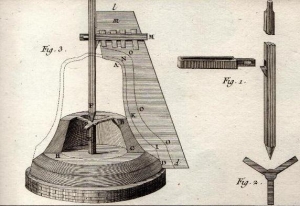Preparazione del Modello
 Si parte dalla preparazione di una sagoma in legno di noce che corrisponde al profilo della campana. Con essa si disegna una struttura cava di mattoni corrispondente all’interno della campana, L’ANIMA, sulla quale viene distribuito un primo strato di argilla. Sull’anima si sovrappongono alcuni strati di speciali argille fino ad ottenere la FALSA CAMPANA che avrà esattamente lo spessore voluto per la campana di bronzo. Su questa superficie, perfettamente levigata, si applicano fregi ed iscrizioni in cera che dedicano e decorano la campana.
Si parte dalla preparazione di una sagoma in legno di noce che corrisponde al profilo della campana. Con essa si disegna una struttura cava di mattoni corrispondente all’interno della campana, L’ANIMA, sulla quale viene distribuito un primo strato di argilla. Sull’anima si sovrappongono alcuni strati di speciali argille fino ad ottenere la FALSA CAMPANA che avrà esattamente lo spessore voluto per la campana di bronzo. Su questa superficie, perfettamente levigata, si applicano fregi ed iscrizioni in cera che dedicano e decorano la campana.
L’ultima fase di formatura consiste nel preparare il MANTELLO ottenuto dalla sovrapposizione di strati di argilla. A modello ultimato viene sollevato il mantello per scoprire la falsa campana che verrà distrutta, il mantello sarà riposizionato sull’anima cosicchè all’interno del modello si sarà creata l’intercapedine nella quale verrà colato il bronzo.
A questo punto Il Modello è pronto per essere collocato nel fosso di colata, ai piedi del forno, per essere interrato. Il modello della campana è bloccato saldamente nella fossa di colata al fine di non subire spostamenti durante la fusione. Il bronzo (78 parti di rame e 22 di stagno) fonde in un grande forno a riverbero, alimentato a legna, alla temperatura di circa 1150°.

